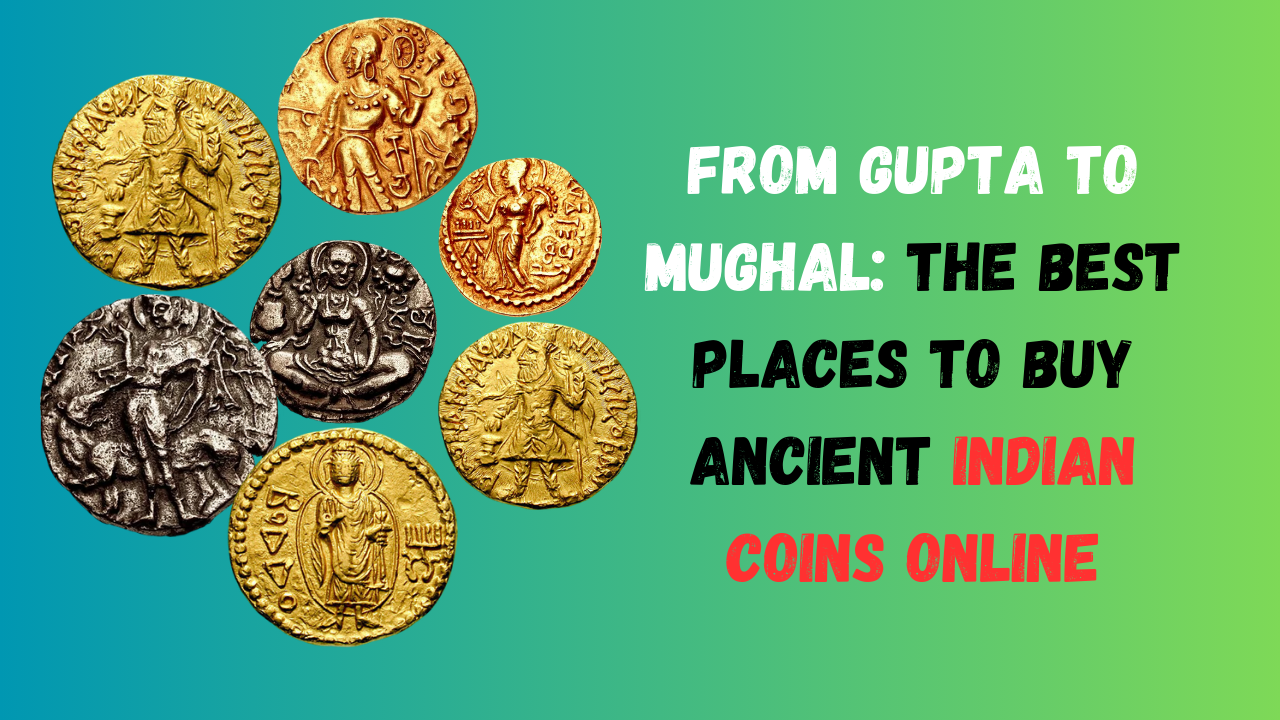Our focus for ancient India is the Gupta Dynasty and Mughal Empire. Coin Bazzar delves into the fascinating world of ancient currency, an interesting experience of times of rising and falling great kingdoms. We have prepared a directory to search authentic antique Indian coins online as we know you would want a piece of this great past.
The Importance of Ancient Indian Coins
Ancient India coins matter because they go in line with India’s rich history and culture. These antique relics reveal ancient civilizations’ economic and political structures. Each coin silently recounts empires rising and crumbling, dynasties prospering, and cross-border cultural interaction. Research into, as well as the preservation of ancient coins may reveal past social standards, creative talent, and technological developments. Ancient Indian coins are a historically as well as aesthetically rich creation. These coins are masterpieces with complex patterns of gods, rulers, or symbolic motifs that represent ancient Indian life. Ancient Indian coins present a reflection of ancient Indian craftsmanship and refined taste in their period.
Like time-transported history, these Indian coins from ancient India help to enhance our knowledge of our cultural history and associate us with our roots. Learning the story behind each of these artifacts shows us how, in fast-paced modern lives, appreciating these ancient treasures can transport us back in time, reminding us of our forefathers’ legacy.
The Gupta Dynasty: A Golden Age of Indian Coins

Prosperity and cultural revival in India arose during the 4th to 6th century CE Gupta Dynasty. During this time, the “Golden Age” of Indian coinage was created; some of the most beautiful cash in world history was made. The Gupta kings were proud of their money, which symbolized their power and achievements and marked trade. Masterful craftsmanship went into Gupta coins. They have exquisite decorations of Hindu deities like Vishnu and Shiva and mythological creations like Garuda. Their superb workmanship was the excellence of their composition in pure gold or silver. These coins acted not only as currencies but also as political tools to enhance the national unity as well as Gupta legitimacy.
Gupta coinage is an epitome of art and cultural brilliance. These ancient Indian coins reveal the rich history and the artistic talent of that period. Now that collectors can buy genuine Gupta coins online, they may own a piece of this golden past and help preserve India’s remarkable heritage.
Exploring the Coins of the Maurya Empire

Discover Maurya Coins:Explore the Maurya Empire and find timeless numismatic treasures. This period’s coins reveal one of India’s most powerful dynasties’ cultural and economic achievements. These coins tell intriguing stories of emperors, deities, and booming trade routes in elaborate designs.
These ancient artifacts really intrigue with their art work. The Maurya coins are filled with religious and political symbols. All the coins are small works of art that comprise elephants, lions, bulls, lotus flowers, and conch shells. These elegant artifacts conveyed authority, richness, and cultural identity while serving as transaction vehicles.
Understanding the Different Types of Ancient Indian Coins
The various forms and styles of ancient Indian coins are fascinating to discover. Punch-marked, die-struck, and cast coins were used in ancient India. Each one of them has historical and artistic value. Ancient India’s earliest currency was punch-marked coins from the 6th century BCE. Flat pieces of silver or copper were punched with symbols to create these coins. The symbols on the coins often represented kings, cities, or values. These emblems shed light on the intricate sociopolitical landscape of ancient India.
After the Maurya period, the coins minted were die-struck. These exquisite coins were made when a metal die was violently struck onto a blank coin disk. The ornate decorations comprise royal portraits, deities, animals, and symbols representing power and prosperity in various ages.
Cast coins were a commonly developed process of currency fabrication during Gupta Dynasty times. In this process, molten metal was filled in molds to produce well uniform and deep coins. Indeed, most cast coins contained beautiful inscriptions and mythical designs or gods .
Evaluating the Authenticity of Ancient Indian Coins

Unsolving Numismatic Mysteries To unravel old Indian currencies, one needs an eagle eye and a curious mind. It is a riveting mission that demands verification of these old historical coins. Authenticity earns your collection credibility and wonderful history of India.
Authenticity checking demands close attention to weight, dimensions, and determination of metallic composition. XRF analysis is used by expert numismatists in establishing authenticity of old Indian coins. XRF thus determines the provenance of the coin and identifies anomalies by considering its elemental composition.
Verifying authenticity: Validating a coin involves looking at every minute engraving on it. Art and scripts help one learn about eras and dynasties. Value is appreciated in each curve, symbol, or script on the coin as this validates authenticity and shows how efficient ancient artists were.
Investing in Ancient India Coins: Why It’s Worth it
Ancient Indian coins are great collections and smart investments with high returns. Collectors all over the world need these coins because they relate to India’s rich history and culture. Rare coins enable investors to become participants in saving history while diversifying their portfolios. The scarcity and limited supply of ancient Indian coins make them an attractive investment. Not only do these pieces of art become rarer with time but also because of some low-production periods. Their prices are higher as more collectors and enthusiasts keep buying them.
Both their historical significance and intrinsic value as metals qualify ancient Indian coins as investment possibilities. Many of the ancient Indian coins were made from gold or silver, hence attracting investors seeking protection from market volatility.
Conclusion
Finally, the ancient Indian coins are a journey into time and culture rather than simply numismatics. Here, they depict India’s glorious dynasties and empires with their enchanting designs and tremendous historical value. Investing in this asset, we carry on its history and stories with us. While browsing upon the trusted internet portals selling authentic old Indian coins, let us connect to our heritage and marvel at this ancient culture.
FAQs
1. Where can I buy ancient Indian coins online?
Auction sites such as eBay, CoinIndia, and VCoins, as well as trustworthy internet marketplaces and specialized numismatic websites, sell ancient Indian coins. Verifying the authenticity certificates provided by the seller is crucial.
2. Are ancient Indian coins valuable?
Indeed, old Indian coins from dynasties like the Mughal or Gupta can be extremely valuable. Rarity, historical relevance, condition, and demand from investors or collectors are some of the variables that determine their value.
3. What makes Gupta and Mughal dynasty coins special?
The historical relevance, elaborate designs, and function of Gupta and Mughal coins in recording ancient Indian emperors, trade, and culture make them extremely valuable. They are valuable due in part to their age and rarity.
4. How can I authenticate ancient Indian coins?
To verify the authenticity of ancient Indian coins, seek advice from qualified numismatists, visit reliable dealers, or employ certification services such as the American Numismatic Association (ANA) or the Numismatic Guaranty Corporation (NGC).

